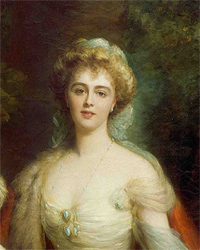Princess Henry ("Daisy") of Pless,
Along with Queen Marie of Romania, Daisy of Pless (who married the Silesian Prince Hans Heinrich XV in 1891) was considered one of the most beautiful royal women in Europe. Her good looks and poses were later to be immortalised both on canvas by the celebrated portrait painters John Singer Sargent, as well as by many other painters such as Bolesław Szańkowski, Ellis William Roberts and Paul-César Helleu, and captured on glass negatives at many photographic sessions at the fashionable London studios, including that of Lafayette, in a variety of fanciful, and sometimes derivative, poses emphasising her semi-sensuous conception of royalty as well as embodying Schlegel's maxim: "Look to the Orient for all that is romantic!" In addition to her increasingly difficult life as an unassimilated Englishwoman in Germany in the years leading up to, and during, the First World War, the loss of her husband’s estates to the new country of Poland after 1918 brought about an estrangement between the couple and the later years of her life ended in divorce, separation from her family, poverty, debilitating illness and a lonely death in territory occupied by Germany during the Second World War. A portrait made on the night of the Ball was published in The Graphic a week after the event. The negative no longer exists in the Lafayette archive, and Daisy, obviously intent upon having a more flattering portrait, was back at the studio in December 1897 later for a more satisfying series of images in this costume. In the reclining portrait, made six months after the Ball, the princess, with almost identical placement of the hands, holds the same enormous palm-leaf pankha that her mother, Patsy, held in an 1881 “professional beauty” portrait produced by the London firm of Downey. As the Queen of Sheba, Daisy wears a dress of purple and gold shot gauze. The train is a mass of red, purple, green, blue and white jewels, thickly encrusting medallions of raised gold. The dress is also set with turquoise ovals with engraved hieroglyphics. Over this she wears a sash of cloth of gold also heavily bejewelled and a massive pearl and diamond sautoir. The costume is topped off with an Assyrian headdress studded with turquoises, emeralds and pearls, with jewels over either ear. The ensemble was described by the press as “a costume of the utmost magnificence.” Princess Daisy had a little competition for her character, or as The Queen, put it:
Her outfit, one of many designed for the Ball by Mrs Mason of London, “must have cost several hundred pounds” - according to one American newspaper, which also declared that “anything more beautiful than Princess Pless’s dress has never been seen.” Other objects, creating an oriental ambience, can be seen in the photograph - such as the fur throw and a backdrop in the style of the Dutch classicist and orientalist painter, Lawrence Alma Tadema (1836-1912) who was active in England. Although the Devonshire House Ball had taken place on the night of the 2 July 1897, this portrait was made over six months later and was reproduced in the Album.
In one of the standing (top) images from the same photographic session, Princess Daisy is seen with an ostrich feather fan. Very unusually for the Princess, her loosely fitting dress and stance fail to highlight her minute waist. The extant four negatives from this photographic session show clearly how a sitter, even in a fancy dress, might go through a variety of poses and use various studio props in an effort to add some dynamism to a photographic study. As Princess Daisy was a well-known performer on stage for society and charitable events, it might be surmised that she, and not the photographer, was directing the shoot. The image published in the Album was erroneously entitled ‘as Cleopatra’, but the following image in the Album, of Daisy’s as yet unmarried sister Shelagh lists her as ‘a courtier in the train of Queen of Sheba’.
|
Click on image to enlarge Click on image to enlarge
By kind permission of Castle Pless. |
||||
|
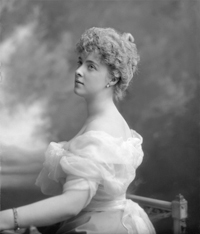

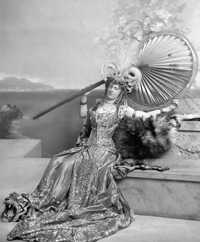 V&A Lafayette Archive
V&A Lafayette Archive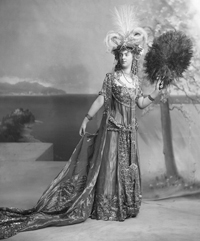 V&A Lafayette Archive
V&A Lafayette Archive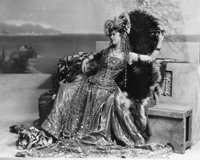 V&A Lafayette Archive
V&A Lafayette Archive V&A Lafayette Archive
V&A Lafayette Archive